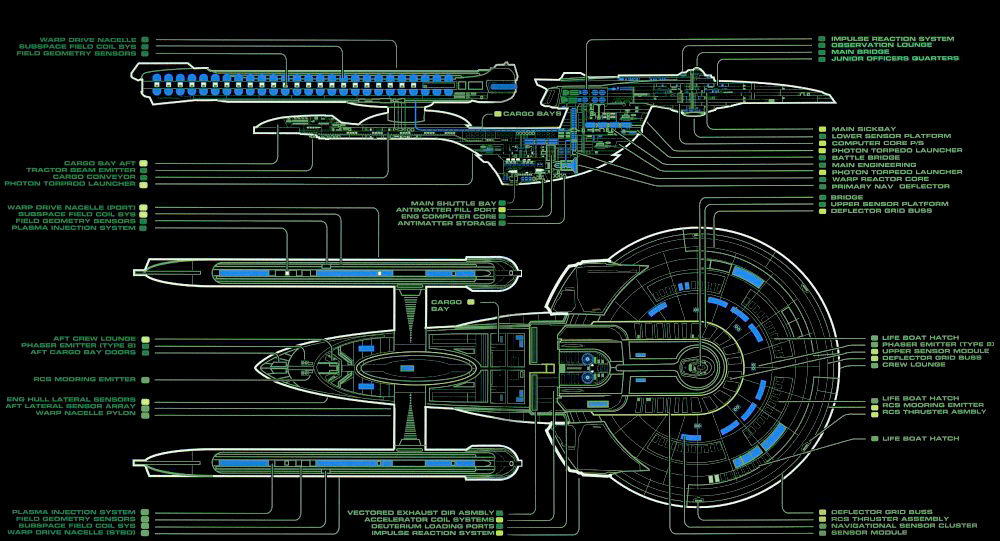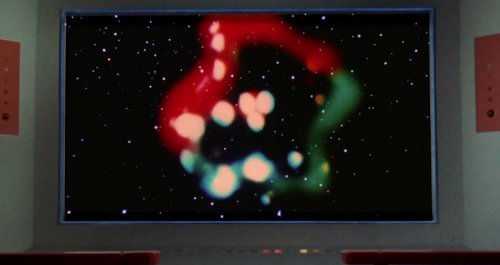You rang????!!!!!
Well, this is a political problem resulting in scaling differences and confusion. The politics involved the thoughts of one series group of writers and producers, versus another team's creative differences.
You're not wrong...there is just no right!
When the Excelsior was introduced, as an experimental vessel (NX prefix), it was intended by the writers to be a massive ship, more than twice the size of the Enterprise and to appear to be more advanced. The idea for the writers and director was to give a sense of threat to the viewer, who would see the big ship as a rival and an adversarial presence to the fan's beloved ship, USS Enterprise, NCC-1701. A scene was written where the threat, that this big, super fast ship, should chase down the Enterprise as it attempted to escape capture.
The punchline to the scene was that the ship was sabotaged by another beloved icon, Scotty. It just chugged to a drift, to the sounds of a failing Model T.
And that was the original plan, as it was executed on screen.
The Excelsior continued to serve as a punchline and friendemy in STIV, when the threatening probe approached Earth, and in a short scene , the Excelsior was gearing up to defend the planet, to only get shut down by the probes radiation defenses. Again, as it prepared to launch as the hero-ship, it stalled.
It appeared that the Excelsior was confined to be the ED-209 of the Star Trek movie franchise, when Star Trek the Next Generation started broadcasting episodes. The series needed older ships that looked attractive enough for the series, and advanced enough for the special effects of the day, and chose to use the excellent and easy to film Excelsior filming model. The problem they had was that the craft was very recognizable (Roddenberry had issued an edict before the launch of Next Gen that the 1701/1701-A model not be used during the run of Next Gen.). There was only one exception to this mandate. The Excelsior model solved the problem of not building an expensive filming model, but the ship was huge. The Reliant model was suggested to bee too small and antiquated-looking for the scenes.
The way the Excelsior was conceived originally by the builder and writers of its first appearance, it was that it was longer than the 1701-D. Massive! Looking at the window placement, rear shuttle bay deck height, and other details supported it to be a rival to the new, duck-shaped Enterprise. The writers and staff didn't want another ship on screen that would dwarf a ship that they had made a big deal of in promotions and previous scripts, as massive and SO much bigger than 1701-D. They came up with a solution; retro-shrink it.
In early episodes, the Excelsior is seen traveling near 1701-D, just smaller to make the Big E still look imposing. No screen mention of the size, before or after, cemented this fact; it was just known around the set to writers and production staff. The NCC-1701-D was the biggest Starfleet ship; period!
Interestingly, there was a wall in the 1701-D lounge of previous Enterprises, including an old aircraft carrier, 1701, 1701-A, an Excelsior version (presumably "B"), and a 1701-C version different from what was shown in a later episode. These were all under the 1701-D silhouette shape. I remember when I first saw this display on the set, that the Excelsior version was larger than how it was depicted in the episodes to follow (close to as long than the 1701-D at the top). Since, as I was told, the golden depictions were supposed to be in scale, it was interesting how the size was still not fully reduced in accordance with the writer's intent (someone didn't get the memo); smaller than what ST III inferred but longer and deeper than the televised side-by-side depictions.
Note of interest: The Excelsior silouette on the wall was again different from the depiction of the Enterprise -B in the movie Generations; without the added hull elements to the aft saucer, fore secondary hull, and warp nacelles. Continuity people! Continuity! Actually the differences were due, reportedly, to a fear that the damage to the Excelsior filming model promoted modifications that were required in the script; more true was the desire for the merchandizing gurus to have a different design to sell in the way of models, toys, and such. 20th century merchandizing contract trumped 24th century continuity.
Adding to the confusion of the Excelsior size was that it seemed to return to the STII size in the last old cast movie; STVI. In STVI, there was a secondary shuttle bay in the open aft of the Excelsior secondary, rear hull. If you look closely, two of the large "executive" transport shuttles, used by the TOS-movie cast in the STVI scene where they return to the 1701-A for the mission to escort the Klingon D-7 to a conference, are srored, side-by-side, in that open shuttle bay (they never showed the doors to this bay, on screen, as it looked too cool to show it open and glowing blue). This was a big shuttle, if you note the placement of doors and windows, and the size of these in the movie (ironically, two of the underside grebes that suggest a propulsion mechanism are NCC-1701-D engine nacelles, glued flat to the bottom! These are followed by a Roman War Bird's engine fore section greeble, all re-colored). These two shuttles are dwarfed in the Excelsior shuttle bay, establishing the size to again be massive, returning to the original movie-intended size. From these shuttles, the rear shuttle bay on the fantail would have a more reasonable three to four deck high shuttle bay; not the deck-in-a half, Next Gen reduction.
If the Excelsior was as small as suggested in Next Gen incarnations (relatively speaking, of course), then the after shuttle bay would barely be over a deck in height; too small for the period shuttles. It would also have two windows per deck in some places of the ship, and decks half the normal height (maybe for First Federation crewmen? Binars? -no; too early...).
So you confusion is reasonable because the ship started out more than twice the length of the 1701 refit, then was shrunk in the Next Gen irritations, then returned to super-size in the last old cast movie (ST-VI), then shrunk in the first Next Gen movie (Generations) where is was 30-33 decks deep, given the deck-to-deck on the rear wall display of the Master Situation Station (smaller than the previous movie plans but larger than depicted in the Next Gen series.).
The inconsistency drives many Trekkers crazy and is a source of debate at conventions; at least it did years ago when I was a guest. Recalling the consistency problems of Next Gen production, I tend to favor the STIII size, as it may be massive, but fits the exterior details of windows, docking bays, and other structures better than the smaller sizes suggested later.



